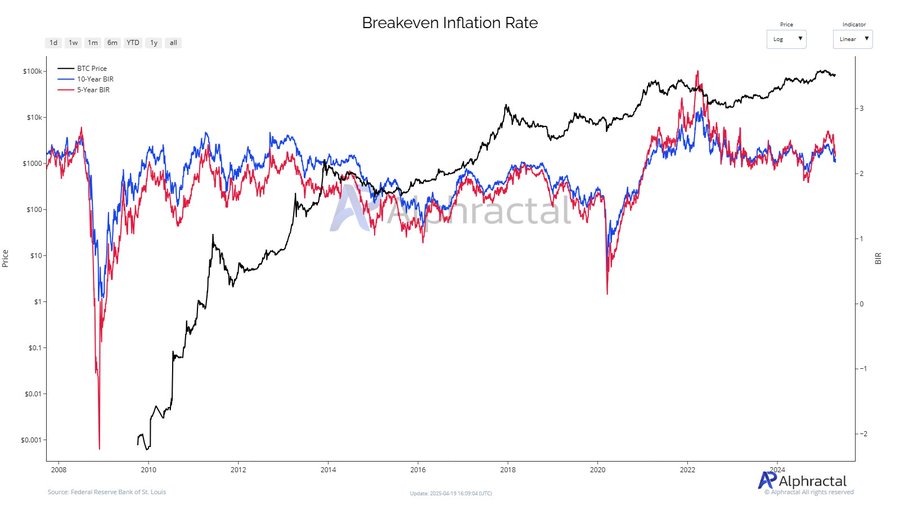-
Bitcoin’s transition towards becoming a traditional asset signifies a notable shift in market dynamics, reflecting broader economic influences.
-
With the diminishing impact of its historical halving cycles, Bitcoin increasingly tracks macroeconomic indicators, particularly inflation rates.
-
According to COINOTAG, “Bitcoin is evolving from a speculative asset to one that mirrors institutional economic behaviors.”
This article explores Bitcoin’s transformation into a macro-sensitive asset, reflecting on its declining halving impacts and evolving economic relationships.
Bitcoin’s halving highs keep shrinking
Each halving cycle once promised monumental gains, but these returns are noticeably waning. The first halving delivered an astonishing 6,400% return, while subsequent halvings saw diminishing returns: the second halving yielded a reduced 3,200%, and the third provided a mere 1,200%.
Currently, the ongoing cycle has barely surpassed 100% — even amidst Bitcoin reaching new all-time highs. This trend highlights a significant shift; Bitcoin’s post-halving rallies are not generating the excitement they once did.

Source: IntoTheBlock
The data reveals that Bitcoin’s response to its halving is weakening, suggesting the market’s mood is shifting away from a simplistic view based solely on supply shocks. With increasing institutional investment and a complex macroeconomic environment, Bitcoin is starting to behave less like a volatile, speculative asset and more like a stable, macro-aware financial instrument.
While the halving still plays a role in moderating supply, it is no longer the dominant factor influencing Bitcoin’s price. Today, Bitcoin’s value is increasingly associated with liquidity cycles and broader economic signals, marking a critical transition in its market behavior.
Bitcoin is now dancing to a different beat
Shifting focus from halving dynamics, Bitcoin’s current valuation seems to resonate more with inflation expectations. Recent data shows Bitcoin’s price closely mirrors 5-year and 10-year breakeven inflation rates — key indicators of anticipated inflation based on the tug-of-war between nominal Treasuries and Treasury Inflation-Protected Securities (TIPS).

Source: Alphractal
When breakeven inflation rates rise, it signals higher expected inflation and drives investors toward alternatives to fiat money, thereby enhancing Bitcoin’s allure as a hedge. Historically, Bitcoin has appeared disconnected from macroeconomic concerns. However, since 2020, its price has become closely linked to inflation forecasts, suggesting a maturation of the asset that is reacting more to Federal Reserve communications than to traditional mining cycles.
Bitcoin is evolving — Here’s why it matters
Originally conceived as a counter to failures within traditional finance and runaway inflation risk, Bitcoin’s current behavior reflects its adaptation to prevailing economic forces. In 2025, it seems that Bitcoin is increasingly influenced by the same elements it was designed to withstand: Federal Reserve policies, liquidity cycles, and real interest rates.
This isn’t inherently contradictory. With heightened institutional adoption, Bitcoin’s market dynamics have evolved to resonate with policy shifts rather than being guided solely by mining metrics or consumer price index adjustments.
As interest rates rise, available capital decreases; non-aggressive monetary policy can therefore reignite investor interest in Bitcoin. Such developments indicate a more responsive and interconnected structure.
However, this evolution generates complex considerations. Can Bitcoin truly maintain its identity as “digital gold” if its value is influenced by the same macroeconomic pressures affecting traditional equities? Or has it transitioned into a liquidity-sensitive asset — one that thrives in capital-rich environments yet recedes when liquidity tightens?
While its fundamental nature remains intact, the shift in its trading environment and pricing mechanisms indicates that Bitcoin has not only matured but also adapted to a more sophisticated economic landscape. Its role as a hedge has evolved; it is no longer merely a fringe asset but now listens closely to the Federal Reserve’s policies.
Conclusion
In summary, Bitcoin’s transformation reflects significant shifts in market behavior, suggesting it is becoming less of a speculative asset and more of a macro-sensitive instrument. As Bitcoin matures, understanding its response to broader economic indicators will be key for investors and enthusiasts alike. Keeping a keen eye on market trends and regulatory adjustments can provide an insightful perspective on Bitcoin’s future trajectory.
